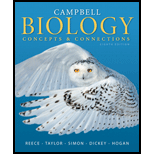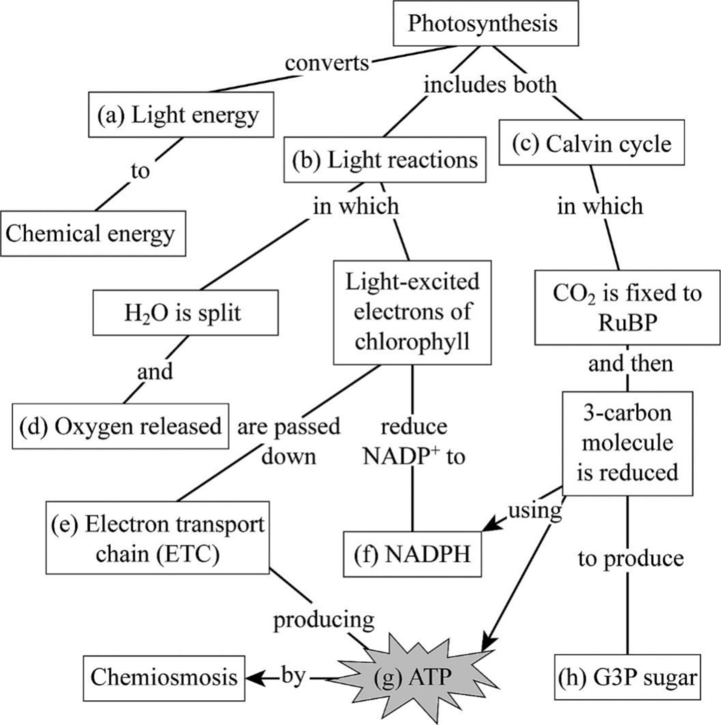
Concept explainers
Complete this summary map of photosynthesis.

To complete: The connect map to summarize the major steps in photosynthesis.
Concept introduction: Photosynthesis is a vital process in primary producers, plants. Plants use light energy and carbon dioxide (CO2) from the atmosphere and produce sugars that are stored in various parts of the plants. The most edible ones are consumed by the primary consumers. Several compounds are converted and recycled in the process of photosynthesis. Several reactions of photosynthesis take place in the chloroplast of the plant cell, which contains the green pigment chlorophyll.
Answer to Problem 1CC
The Fig.1 shows all the key processes in photosynthesis.
Pictorial representation:
The Fig. 1shows the summary of all the processes involved in photosynthesis.

Fig 1: Summary of various steps in photosynthesis.
Explanation of Solution
(a)
Correct answer: Light energy
In the process of photosynthesis, photons from light energy are converted into chemical energy. In the visible spectrum of light, the red and blue wavelengths are used to initiate the reactions of photosynthesis. The light energy is used up to break the water molecule by the process called photolysis of water, which is the first step in photosynthesis.
Hence, the correct answer is light energy.
(b)
Correct answer: Light reactions
Photosynthesis includes two reactions, namely, light-dependent and light-independent reactions. Light reactions are those that are dependent on the incident light energy on the chloroplast. Light reactions include two sub steps. One reaction is the photolysis of water where light energy is used up to break the water molecules to produce an oxygen molecule and protons. The second reaction is where these protons and the energy released during photolysis of water are used up to excite the electrons in the chlorophyll.
Hence, the correct answer is light reactions.
(c)
Correct answer: Calvin cycle
The CBB (Calvin–Benson–Bassham) cycle or Calvin’s cycle is a series of reactions that take place in the stroma of the chloroplast. The Calvin’s cycle is a light-independent reaction, which is also known as the dark reaction. In the Calvin’s cycle, the atmospheric carbondioxide is fixed with ribulose1, 5-bisphosphate to produce two 3-carbon compounds. One of the two 3-carbon compounds is reduced to form another sugar.
Hence, the correct answer is the Calvin cycle
(d)
Correct answer: Oxygen released
During one of the light reactions, that is, photolysis of water, the light energy is used up to break two molecules of water to produce one molecule of oxygen, 4 electrons, and 4 protons (H+). The oxygen molecule then escapes the chloroplast and is released into the atmosphere.
Hence, the correct answer is oxygen released
(e)
Correct answer: Electrontransportchain(ETC)
During the second light reaction of photosynthesis, the electrons released from photolysis of water are passed on through the photosystem II and photosystem I and are then sent to the electron transport chain. In the electron transport chain, the protons released during photolysis of water are used by F0-F1 ATP synthase to produce ATP.
Hence, the correct answer is the electron transport chain (ETC)
(f)
Correct answer: Nicotinamide adenine dinucleotide phosphate (NADPH)
During the second light reaction of photosynthesis, the electrons released from photolysis of water are passed on through the photosystem II and photosystem I, which at the end of photosystem II reduce NAD+ to NADPH. This NADPH is then used up during the hexose monophosphate pathway to produce several sugars, and it is also used during the Calvin’s cycle to produce sugars.
Hence, the correct answer is NADPH
(g)
Correct answer: ATP
The electrons released from photolysis of water are passed on through the photosystem II and then from the photosystem to the electron transport chain. In the electron transport chain, the protons released during photolysis of water are used by F0-F1 ATP synthase present on the thylakoid membrane of the chloroplast to produce ATP. This ATP is used up along with NADPH to produce several sugars in the Calvin’s cycle.
Hence, the correct answer is ATP
(h)
Correct answer: Glyceraldehyde 3-phosphate (G3P)(sugar)
During the Calvin’s cycle, the NADPH and ATP produced during the light reactions and F0-F1 ATP synthase, respectively, are used up to reduce ribulose 1.5-bisphosphate to produce two molecules of G3P. For every 3 molecules of carbondioxide entering the Calvin’s cycle, one G3P is produced. Few G3Ps are sent for the production of 6-carbon sugars and others are recycled back to produce ribulose 1,5-bisphosphate.
Hence, the correct answer is G3P (sugar)
Want to see more full solutions like this?
Chapter 7 Solutions
Campbell Biology: Concepts & Connections (8th Edition)
- For short answer questions, write your answers on the line provided. To the right is the mRNA codon table to use as needed throughout the exam. First letter U บบบ U CA UUCPhe UUA UCU Phe UCC UUG Leu CUU UAU. G U UAC TV UGCys UAA Stop UGA Stop A UAG Stop UGG Trp Ser UCA UCG CCU] 0 CUC CUA CCC CAC CAU His CGU CGC Leu Pro CCA CAA Gin CGA Arg CUG CCG CAG CGG AUU ACU AAU T AUC lle A 1 ACC Thr AUA ACA AUG Mot ACG AGG Arg GUU GCU GUC GCC G Val Ala GAC Asp GGU GGC GUA GUG GCA GCG GAA GGA Gly Glu GAGJ GGG AACASH AGU Ser AAA1 AAG Lys GAU AGA CAL CALUCAO CAO G Third letter 1. (+7) Use the table below to answer the questions; use the codon table above to assist you. The promoter sequence of DNA is on the LEFT. You do not need to fill in the entire table. Assume we are in the middle of a gene sequence (no need to find a start codon). DNA 1 DNA 2 mRNA tRNA Polypeptide C Val G C. T A C a. On which strand of DNA is the template strand (DNA 1 or 2)?_ b. On which side of the mRNA is the 5' end (left or…arrow_forward3. (6 pts) Fill in the boxes according to the directions on the right. Structure R-C R-COOH OH R-OH i R-CO-R' R R-PO4 R-CH3 C. 0 R' R-O-P-OH 1 OH H R-C-H R-N' I- H H R-NH₂ \H Name Propertiesarrow_forward4. (6 pts) Use the molecule below to answer these questions and identify the side chains and ends. Please use tidy boxes to indicate parts and write the letter labels within that box. a. How many monomer subunits are shown? b. Box a Polar but non-ionizable side chain and label P c. Box a Basic Polar side chain and label BP d. Box the carboxyl group at the end of the polypeptide and label with letter C (C-terminus) H H OHHO H H 0 HHO H-N-CC-N-C-C N-C-C-N-GC-OH I H-C-H CH2 CH2 CH2 H3C-C+H CH2 CH2 OH CH CH₂ C=O OH CH2 NH2arrow_forward
- please draw in what the steps are given. Thank you!arrow_forwardplease draw in and fill out the empty slots from image below. thank you!arrow_forwardThere is a species of eagle, which lives in a tropical forest in Brazil. The alula pattern of its wings is determined by a single autosomal gene with four alleles that exhibit an unknown hierarchy of dominance. Genetic testing shows that individuals 1-1, 11-4, 11-7, III-1, and III-4 are each homozygous. How many possible genotypes among checkered eagles in the population?arrow_forward
 Concepts of BiologyBiologyISBN:9781938168116Author:Samantha Fowler, Rebecca Roush, James WisePublisher:OpenStax College
Concepts of BiologyBiologyISBN:9781938168116Author:Samantha Fowler, Rebecca Roush, James WisePublisher:OpenStax College
 Biology 2eBiologyISBN:9781947172517Author:Matthew Douglas, Jung Choi, Mary Ann ClarkPublisher:OpenStax
Biology 2eBiologyISBN:9781947172517Author:Matthew Douglas, Jung Choi, Mary Ann ClarkPublisher:OpenStax Biology Today and Tomorrow without Physiology (Mi...BiologyISBN:9781305117396Author:Cecie Starr, Christine Evers, Lisa StarrPublisher:Cengage Learning
Biology Today and Tomorrow without Physiology (Mi...BiologyISBN:9781305117396Author:Cecie Starr, Christine Evers, Lisa StarrPublisher:Cengage Learning Biology: The Dynamic Science (MindTap Course List)BiologyISBN:9781305389892Author:Peter J. Russell, Paul E. Hertz, Beverly McMillanPublisher:Cengage Learning
Biology: The Dynamic Science (MindTap Course List)BiologyISBN:9781305389892Author:Peter J. Russell, Paul E. Hertz, Beverly McMillanPublisher:Cengage Learning Biology (MindTap Course List)BiologyISBN:9781337392938Author:Eldra Solomon, Charles Martin, Diana W. Martin, Linda R. BergPublisher:Cengage Learning
Biology (MindTap Course List)BiologyISBN:9781337392938Author:Eldra Solomon, Charles Martin, Diana W. Martin, Linda R. BergPublisher:Cengage Learning





